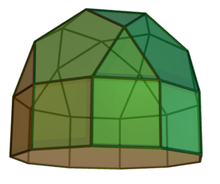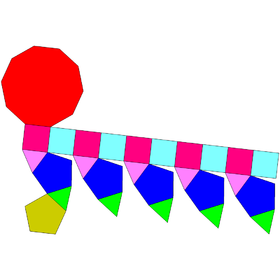Elongated pentagonal rotunda
| Elongated pentagonal rotunda | |
|---|---|
 | |
| Type | Johnson J20 - J21 - J22 |
| Faces | 2.5 triangles 2.5 squares 1+5 pentagons 1 decagon |
| Edges | 55 |
| Vertices | 30 |
| Vertex configuration | 10(42.10) 10(3.42.5) 2.5(3.5.3.5) |
| Symmetry group | C5v |
| Dual polyhedron | - |
| Properties | convex |
| Net | |
 | |
In geometry, the elongated pentagonal rotunda is one of the Johnson solids (J21). As the name suggests, it can be constructed by elongating a pentagonal rotunda (J6) by attaching a decagonal prism to its base. It can also be seen as an elongated pentagonal orthobirotunda (J42) with one pentagonal rotunda removed.
A Johnson solid is one of 92 strictly convex polyhedra that is composed of regular polygon faces but are not uniform polyhedra (that is, they are not Platonic solids, Archimedean solids, prisms, or antiprisms). They were named by Norman Johnson, who first listed these polyhedra in 1966.[1]
Formulae
The following formulae for volume and surface area can be used if all faces are regular, with edge length a:[2]
Dual polyhedron
The dual of the elongated pentagonal rotunda has 30 faces: 10 isosceles triangles, 10 rhombi, and 10 quadrilaterals.
| Dual elongated pentagonal rotunda | Net of dual |
|---|---|

|

|
References
- ^ Johnson, Norman W. (1966), "Convex polyhedra with regular faces", Canadian Journal of Mathematics, 18: 169–200, doi:10.4153/cjm-1966-021-8, MR 0185507, Zbl 0132.14603.
- ^ Stephen Wolfram, "Elongated pentagonal rotunda" from Wolfram Alpha. Retrieved July 22, 2010.


